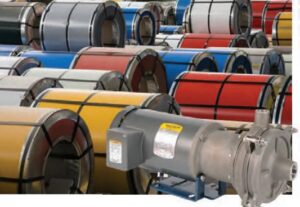 Steel coil coater solves leak issue with magnetic drive pump
Steel coil coater solves leak issue with magnetic drive pump
December 22, 2021 REDWIRE is news you can use from leading suppliers. Powered by FRASERS.
Posted by John Brooks Company Limited
John Brooks Company Limited: Fluid Handling Solution providers since 1938. For over 80 years, John Brooks Company has pr... Read more
Subscribe
Free REDWIRE e-newsletter

John Brooks Company recommended a unique centrifugal pump model.
Among the many customer success stories in John Brooks Company Limited’s history is one involving the largest steel coil coater in Canada. This organization was using an insufficient pump system that leaked methyl ethyl ketone (MEK) into an explosion-proof area, leading to safety concerns, needless downtime, and high costs.
John Brooks Company solved these issues by recommending a Price 2MS75MD magnetic drive centrifugal pump.
Withstanding caustic, corrosive substances
The steel coil coater operates two coating lines that paint more than 200,000 tons of steel each year, for clients in construction and other sectors. The existing pump system transferred MEK with xylene, toluene, and benzene solvent from a charge tank into the facility. As a result, the pumps had to start and stop repeatedly to maintain the necessary 45-psig pressure in the transfer tank. This process led to constant mechanical seal failures on the pumps. Among the customer’s issues were safety, ongoing containment requirements to stop a negative environmental effect from the leaked chemical, production loss, and high maintenance.
So the customer contacted an application expert with John Brooks Company. The expert suggested the 2MS75MD, which withstands caustic and corrosive substances, with a VFD and control panel. Unlike standard centrifugal pumps, this model uses a magnetic field to rotate the impeller instead of a direct drive connection between the impeller and motor. The pump has an outer magnetic bell housing mounted on the end of the shaft and aligned on the outside of the rear casing, while a smaller magnet inside the pump rides on an internal shaft and bushing assembly connected to the impeller. When the motor starts, the housing rotates while affecting the inner magnet; as both magnets turn, the magnetic field rotates the impeller, which displaces the liquid.
The customer saw immediate benefits: no leaks, which saved thousands of dollars a year in lost chemicals; lower maintenance; minimal service and part replacement; reliable operation; improved employee safety; and less effect on the environment. The pump is still operational today.
To learn more about this case study and others, visit the website.
For more information, contact John Brooks Company.
Share
Posted by John Brooks Company Limited
John Brooks Company Limited: Fluid Handling Solution providers since 1938. For over 80 years, John Brooks Company has pr... Read more
